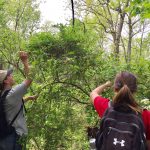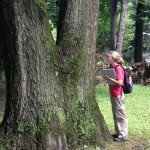Myla Aronson, Department of Ecology, Evolution adn Natural Resources
Lena Struwe, Department of Plant Biology
Search Results for: "Myla Aronson"
Know Your Backyard’s Biodiversity
Rutgers Bioblitz and other nature-based apps help students of all ages honor 50th Earth Day at home There are not many upsides to being stuck at home during a pandemic. But since our shelter-in-place orders overlap with the start of spring and the 50th anniversary of Earth Day (April 22), it does present a unique opportunity to get […]
Rutgers Bioblitz, Phone Apps Encourage Earth Day Home Schooling
Myla Aronson – Department of Ecology, Evolution and Natural Resources
Rutgers Bioblitz, Phone Apps Encourage Earth Day Home Schooling
Myla Aronson – Department of Ecology, Evolution and Natural Resources
Plants in the City: Herbaria as Lenses into the Past to Better See Our Future
Amy Gage, Ameen Lotfi, and Lena Struwe contributed to this article. On the first warm and sunny spring Saturday this year, scientists, students, naturalists and herbaria enthusiasts alike gathered away from the sun in a Rutgers conference room for the Mid-Atlantic Megalopolis: “Plants in the City” symposium on March 30. They set aside any weekend […]
Yards With Non-Native Plants Create ‘Food Deserts’ for Bugs and Birds
Myla Aronson – Department of Ecology, Evolution and Natural Resources
Appalachian Mountain Club’s AMC Outdoors Magazine Features Hutcheson Memorial Forest
Source: Department of Ecology, Evolution and Natural Resources For more than 60 years, Mettler’s Woods, an old growth forest at Hutcheson Memorial Forest Center, has served Rutgers Department of Ecology, Evolution and Natural Resources students and faculty as a classroom, research site, and natural wonder. While ancient oaks and hickory still tower above visitors, much […]
Cities as Novel Ecosystems: Adaptions to Urban Conditions
Are cities unnatural? Are urban landscapes disturbed or damaged? “There is no right answer. We can think of cities in many ways,” says Dr. Paige S. Warren of the University of Massachusetts. “Cities are sources of novelty, hotpots of resource inputs, and drivers of evolutionary change.”.. And what about the plants? With access to floras from 112 cities including both natural and spontaneous vegetation since 1975, Dr. Myla Aronson of Rutgers University along with the Urban Biodiversity Research Coordination Network (UrBioNet) is asking questions about the ways in which cities influence global, regional, and local patterns in plant diversity.
Eliana Geretz ’15: Moss, the Whimsical and Overlooked Flora
“The mosses were just labelled Moss 1, Moss 2, that it just struck me how much mosses are overlooked,” says Eliana Geretz, ecology, evolution and natural resources major. At the time, she was helping conduct research in Hutcheson Memorial Forest in nearby Somerset County. One of the last uncut forests in the Mid-Atlantic States, the […]
30 Species Discovered … in L.A.? Cities Buzz With Life
Urban biodiversity isn’t just limited to buzzing insects. Last year, a study found that 54 cities are home to 20 percent of the world’s bird species. In the city of Lyon, scientists found nearly a third of all the bee species native to France. It turns out that cities are a good place for some animals to live- and how humans decide to manage their cities can make those habitats better or worse for the local fauna… Anyone who has ever walked through a flock of pigeons knows birds do pretty well in cities, too. That isn’t to say that birds prefer cities- urban areas only retain about 8 percent of the bird species that otherwise would have lived in the area, according to a study led by Myla Aronson of Rutgers University… But cities are still filled with a rich variety of birds. Aronson and her team looked at 54 cities around the world and found that 20 percent of known bird species can be found flying in urban centers…”From city to city, across the world, maintaining natural habitat within a city is important for biodiversity,” Aronson told NBC News.





